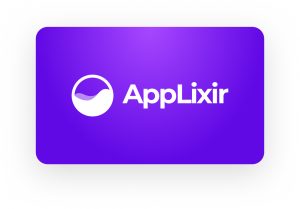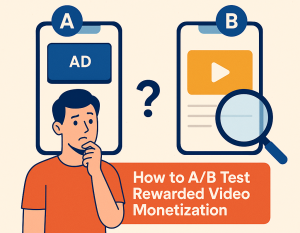Why Guess When You Can Test? How to A/B Test Rewarded Video Monetization
Why guess when you can test? Assumptions can cost you thousands of dollars in lost ad revenue. While many developers implement rewarded video ads and hope for the best, the smartest studios treat monetization like a science—constantly testing, measuring, and optimizing.
A/B testing your rewarded video monetization strategy isn’t just best practice; it’s essential for maximizing your game’s earning potential. Small tweaks to ad placement timing, reward amounts, or button design can dramatically impact your eCPM, user retention, and overall ad revenue. The difference between a mediocre monetization strategy and a profitable one often comes down to systematic testing.
Contents
Why A/B Testing Matters in Rewarded Video Monetization
Most games launch with a static ad setup—rewarded video ads appear at predetermined moments with fixed reward values and placement strategies. Developers implement what feels right or copy what competitors are doing, then move on to other features. This approach leaves massive revenue opportunities on the table.
The problem with static rewarded video ads setups is that they’re built on assumptions rather than data. What works brilliantly for one game might underperform in yours. Player demographics, game genres, session lengths, and progression systems all influence how users interact with reward advertisement opportunities. Without testing, you’re flying blind.
A/B testing transforms guesswork into certainty. By systematically comparing different approaches, you discover exactly what drives higher CPM rates, increases ad impressions per user, and improves user engagement without harming retention. The benefits compound over time—a 10% improvement in eCPM might seem modest, but across millions of impressions, it translates to substantial additional mobile game ad revenue.
Game monetization strategies built on continuous testing adapt to changing player behavior, seasonal trends, and market conditions. While your competitors stick with outdated assumptions, you’re constantly improving your rewarded video ads revenue through systematic experimentation.
What Elements Can Be A/B Tested in Rewarded Video Ads?
The beauty of A/B testing rewarded video monetization lies in the sheer number of variables you can experiment with. Understanding which elements to test gives you a roadmap for continuous optimization.
Ad Placement Timing is perhaps the most impactful variable. Should rewarded videos appear after level completion, during natural gameplay pauses, or only through optional buttons? Testing different timing strategies reveals when players are most receptive. Some games find success with post-defeat placements offering continues, while others discover that celebration moments after victories drive higher engagement.
Frequency Caps determine how often individual users can view rewarded ads. Too restrictive and you limit potential mobile game ads impressions; too generous and you risk ad fatigue or diluting reward value. A/B testing different cap levels—say, 5 versus 10 ads per day—shows you the sweet spot that maximizes revenue without overwhelming players.
Reward Amounts directly influence whether users choose to watch ads. Should you offer 50 coins or 100? A power-up or currency? Testing variations reveals what motivates your specific player base. Sometimes counter-intuitive findings emerge—smaller rewards viewed more frequently can outperform larger, rarer ones.
Ad Networks and Demand Sources vary significantly in their CPM rates and fill rates. Your video monetization platform might support multiple ad networks through mediation. Testing which networks or waterfalls deliver the best eCPM for your traffic helps you optimize your demand strategy and maximize video ads earning potential.
UI/UX Presentation encompasses everything from button colors and sizes to label text and icon design. Does “Watch for Bonus” outperform “Free Reward”? Is a blue button more clickable than green? Small design choices influence click-through rates and ad impressions dramatically.
Skip Options and Delays affect both user experience and revenue. Some platforms allow testing whether users can skip after 5 seconds versus watching the full duration, or whether eliminating skip options increases completion rates enough to offset potential frustration.
Each variable represents an opportunity to fine-tune your monetization strategy. The key is testing them systematically, one at a time, to isolate what actually moves the needle on your game monetization models.
Setting Up a Rewarded Video A/B Test: Step-by-Step
Successful A/B testing follows a structured approach. Rushing into experiments without proper setup leads to inconclusive results and wasted time.
Step 1: Define Your Goal
Start by identifying exactly what you want to improve. Are you optimizing for maximum ad revenue? Better user retention? Higher eCPM? Increased impressions per DAU? Your goal determines which metrics you’ll prioritize and how you’ll evaluate success. Be specific—”increase ARPDAU by 15%” is better than “make more money.”
Step 2: Select One Variable to Test
Resist the temptation to test multiple changes simultaneously. If you modify both ad timing and reward amounts, you won’t know which change drove your results. Isolate a single variable for each experiment. This discipline ensures your data provides clear, actionable insights.
Step 3: Choose Your Test Groups
A standard 50/50 split works well for most mobile app monetization strategies, but you might prefer 90/10 if testing something risky. Ensure your groups are randomly assigned and large enough to provide statistical significance—generally thousands of users minimum. Consider whether you need to segment by user characteristics like install date, spending tier, or geographic region.
Step 4: Implement Using an A/B Testing Framework
Modern Unity monetization setups, Admob rewarded ads implementations, and specialized rewarded video ads SDKs often include built-in A/B testing capabilities. Firebase Remote Config excels at mobile game experiments, while Unity Analytics provides integrated testing tools. If you’re using a platform like AppLixir or similar video monetization platforms, check whether their dashboard offers native testing features. Proper implementation ensures reliable data collection and minimizes technical issues.
Step 5: Run the Test for Statistical Significance
Patience is crucial. Most mobile game monetization models require at least 7-14 days of data collection to account for weekly usage patterns and achieve statistical confidence. Avoid the urge to peek at results daily or call tests early when you see positive trends. Let your experiment run until you’ve collected enough data for reliable conclusions—typically until you reach 95% statistical confidence with adequate sample sizes.
Document everything: hypothesis, implementation details, test duration, and any external factors like app store featuring or marketing campaigns that might influence results.
Measuring and Analyzing Results
Data without analysis is just noise. Knowing which KPIs to track and how to interpret them separates successful monetization optimization from random guessing.
eCPM (Effective Cost Per Mille) measures how much revenue you generate per thousand ad impressions. This is your north star metric for rewarded video ads revenue. Higher eCPM means you’re earning more from the same traffic. Track this metric at the impression level and compare across test variants.
ARPDAU (Average Revenue Per Daily Active User) shows the big picture impact on game monetization. While eCPM measures ad efficiency, ARPDAU captures total revenue impact including how many ads users actually watch. A variant might have lower eCPM but drive higher ARPDAU if it increases ad engagement significantly.
Retention Rate ensures your monetization strategy doesn’t harm the player experience. Compare Day 1, Day 7, and Day 30 retention between test groups. If a variant boosts ad revenue but tanks retention, it’s not a sustainable win. The best mobile game ads strategies enhance both revenue and retention simultaneously.
Ad Completion Rate indicates how many users who start watching rewarded videos actually finish them. Low completion rates suggest timing issues, uninteresting rewards, or technical problems. This metric helps diagnose why certain variations underperform.
Impressions per DAU measures how many rewarded ads the average active user watches daily. This reveals engagement levels and helps identify whether you’re maximizing opportunities without overwhelming players. Significant drops might indicate ad fatigue or poor placement strategies.
Statistical significance determines when you can trust your results. Online calculators help you determine if differences between variants are real or just random chance. Generally, aim for 95% confidence and ensure both test groups have sufficient sample sizes—at least several thousand users each for mobile game monetization experiments.
Tools like Google Analytics, Firebase, Unity Analytics, or specialized ad revenue calculators help visualize trends and perform statistical analysis. Export raw data for deeper analysis in spreadsheets or BI platforms when needed.
AppLixir Rewarded Video Ad Summary
A/B testing transforms rewarded video monetization from guesswork into science. While competitors rely on intuition and industry assumptions, data-driven developers systematically discover what actually works for their specific games and audiences. The difference in ad revenue can be substantial—often 20-40% improvements from methodical optimization over static implementations.
Every element of your rewarded video ads presents an opportunity for testing and improvement. Placement timing, reward amounts, frequency caps, ad networks, UI presentation—each variable influences your eCPM, ARPDAU, and player satisfaction differently. By testing systematically, measuring carefully, and applying learnings strategically, you unlock revenue potential that remains hidden to developers who guess instead of test.
The best time to start A/B testing was at launch. The second-best time is today. Begin with a single, high-impact variable—perhaps ad placement timing or reward amount. Follow the structured approach outlined in this guide: define clear goals, isolate one variable, run tests long enough for statistical significance, and let data guide your decisions.
Remember that optimization is a journey, not a destination. Market conditions evolve, player preferences shift, and new monetization tools emerge. The studios that thrive are those that embrace continuous testing, learn from every experiment, and build organizational cultures around data-driven improvement.
Start A/B testing your rewarded video ads today and unlock your game’s full revenue potential. Your players—and your bottom line—will thank you for choosing data over guesswork.
